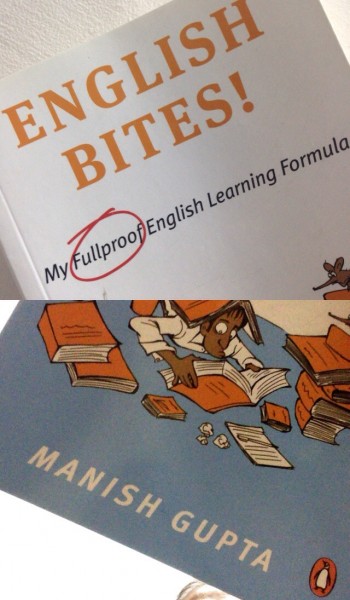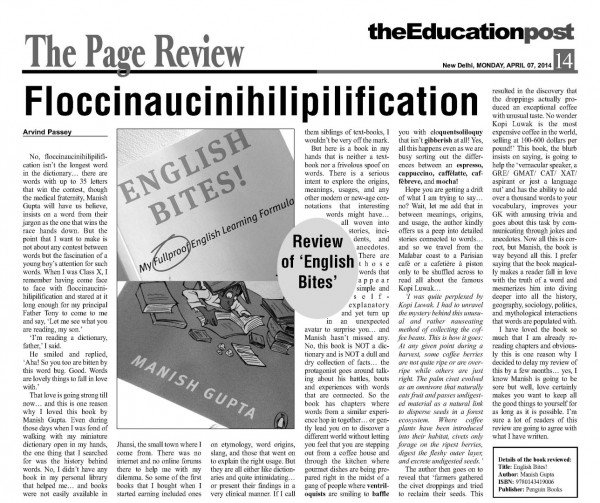No, floccinaucinihilipilification isn’t the longest word in the dictionary… there are words with up to 35 letters that win the contest, though the medical fraternity, Manish Gupta will have us believe, insists on a word from their jargon as the one that wins the race hands down. But the point that I want to make is not about any contest between words but the fascination of a young boy’s attention for such words. When I was Class X, I remember having come face to face with floccinaucinihilipilification and stared at it long enough for my principal Father Tony to come to me and say, ‘Let me see what you are reading, my son.’
‘I’m reading a dictionary, father,’ I said.
He smiled and replied, ‘Aha! So you too are bitten by this word bug. Good. Words are lovely things to fall in love with.’
That love is going strong till now… and this is one reason why I loved this book by Manish Gupta. Even during those days when I was fond of walking with my miniature dictionary open in my hands, the one thing that I searched for was the history behind words. No, I didn’t have any book in my personal library that helped me… and books were not easily available in Jhansi, the small town where I come from. There was no internet and no online forums there to help me with my dilemma. So some of the first books that I bought when I started earning included ones on etymology, word origins, slang, and those that went on to explain the right usage. But they are all either like dictionaries and quite intimidating… or present their findings in a very clinical manner. If I call them siblings of text-books, I wouldn’t be very off the mark.
But here is a book in my hands that is neither a text-book nor a frivolous spoof on words. There is a serious intent to explore the origins, meanings, usages, and any other modern or new-age connotations that interesting words might have… all woven into stories, incidents, and anecdotes. There are those words that appear simple and self-explanatory and yet turn up in an unexpected avatar to surprise you… and Manish hasn’t missed any. No, this book is NOT a dictionary and is NOT a dull and dry collection of facts… the protagonist goes around talking about his battles, bouts and experiences with words that are connected. So the book has chapters where words from a similar experience hop in together… or gently lead you on to discover a different world without letting you feel that you are stepping out from a coffee house and through the kitchen where gourmet dishes are being prepared right in the midst of a gang of people where ventriloquists are smiling to baffle you with eloquent soliloquy that isn’t gibberish at all! Yes, all this happens even as we are busy sorting out the differences between an espresso, cappuccino, caffè latte, caffè breve, and mocha!
Hope you are getting a drift of what I am trying to say… no? Wait, let me add that in between meanings, origins, and usage, the author kindly offers us a peep into detailed stories connected to words… and so we travel from the Malabar coast to a Parisian café or a cafetière à piston only to be shuffled across to read all about the famous Kopi Luwak…
‘I was quite perplexed by Kopi Luwak. I had to unravel the mystery behind this unusual and rather nauseating method of collecting the coffee beans. This is how it goes: At any given point during a harvest, some coffee berries are not quite ripe or are overripe while others are just right. The palm civet evolved as an omnivore that naturally eats fruit and passes undigested material as a natural link to disperse seeds in a forest ecosystem. Where coffee plants have been introduced into their habitat, civets only forage on the ripest berries, digest the fleshy outer layer, and excrete undigested seeds.’
The author then goes on to reveal that ‘farmers gathered the civet droppings and tried to reclaim their seeds. This resulted in the discovery that the droppings actually produced an exceptional coffee with unusual taste. No wonder Kopi Luwak is the most expensive coffee in the world, selling at 100-600 dollars per pound!’ This book, the blurb insists on saying, is going to help the ‘vernacular speaker, a GRE/ GMAT/ CAT/ XAT/ aspirant or just a language nut’ and has the ability to add over a thousand words to your vocabulary, improves your GK with amusing trivia and goes about this task by communicating through jokes and anecdotes. Now all this is correct, but Manish, the book is way beyond all this. I prefer saying that the book magically makes a reader fall in love with the truth of a word and mesmerizes him into diving deeper into all the history, geography, sociology, politics, and mythological interactions that words are populated with.
I have loved the book so much that I am already re-reading chapters and obviously this is one reason why I decided to delay my review of this by a few months… yes, I know Manish is going to be sore but well, love certainly makes you want to keep all the good things to yourself for as long as it is possible. I’m sure a lot of readers of this review are going to agree with what I have written.
Details of the book reviewed:
Title: English Bites!
Author: Manish Gupta
ISBN: 9780143419006
Publisher: Penguin Books
Arvind Passey
07 April 2014
This review was also published in ‘The Education Post’ dated 07 April 2014…












2 comments
anuja bhatt says:
Apr 8, 2014
I cannot wait to read this book. You are posts are really great. It makes me wanna come back and read for more, now I am one of your regular readers.
Arvind Passey says:
Apr 13, 2014
Thanks for the heart-warming words, Anuja… I am certainly catalysed to write better now. Do keep coming. 🙂